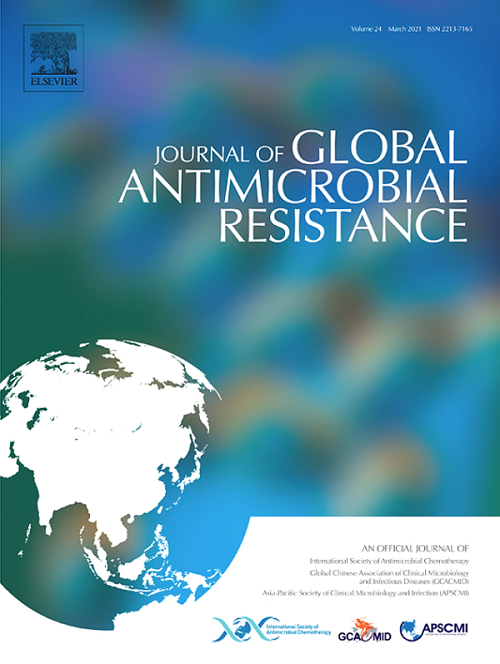头孢洛桑/他唑巴坦处方模式和有效性的真实世界分析:慢性肺部疾病和呼吸相关感染的光谱分析。
IF 3.2
3区 医学
Q2 INFECTIOUS DISEASES
引用次数: 0
摘要
目的:在医院环境中,既存在抗生素耐药的革兰氏阴性(GN)细菌,又在治疗过程中产生耐药性的细菌,都构成了重大挑战,往往导致显著的发病率和死亡率。这项研究的重点是来自SPECTRA研究的慢性肺部疾病(CPD)和呼吸相关感染(RRI),包括肺炎。了解头孢唑烷/他唑巴坦(C/T)治疗患者的实际临床使用和结果至关重要。方法:多国SPECTRA研究利用住院患者图表回顾来描述现实世界的实践,并收集住院患者接受C/T治疗的结果数据。该分析的重点是来自CPD和RRI患者SPECTRA队列的次要数据(RRI最常见的情况包括肺炎和慢性呼吸道感染加重[ECRI])。结果:在2016年1月至2020年10月期间,纳入了接受C/T≥48小时的CPD患者180例,RRI患者275例,肺炎患者182例,ECRI患者91例。CPD、RRI、肺炎和ECRI患者的平均(标准差[SD])年龄分别为57.5(18.7)岁、55.8(18.2)岁、57.8(17.4)岁和51.8(19.1)岁。铜绿假单胞菌是最常见的病原体,分别占CPD、RRI、肺炎和ECRI患者的91.5%、91.8%、88.0%和97.0%;耐多药菌株分别占CPD、RRI、肺炎和ECRI患者的76.9%、74.7%、68.4%和80.3%。CPD、RRI、肺炎和ECRI患者的临床成功率分别为69.4%、66.2%、59.9%、79.1%。结论:SPECTRA亚组分析显示,C/T在治疗CPD和RRI患者中的实际应用显著,与之前的对照研究一致。本文章由计算机程序翻译,如有差异,请以英文原文为准。
Real-world analysis of ceftolozane/tazobactam prescribing patterns and effectiveness: SPECTRA analysis on chronic pulmonary diseases and respiratory-related infections
Objectives
In hospital settings, both pre-existing antibiotic-resistant Gram-negative (GN) bacteria and those that develop resistance during treatment pose significant challenges, often contributing to significant morbidity and mortality. This study focuses on chronic pulmonary disease (CPD) and respiratory-related infections (RRI), including pneumonia, from SPECTRA study. Understanding the real-world clinical use and outcomes for patients treated with ceftolozane/tazobactam (C/T) is essential.
Methods
The multi-national SPECTRA study utilised inpatient chart reviews to describe real-world practice and collect outcome data in hospitalised patients treated with C/T. This analysis focuses on secondary data from SPECTRA cohorts of CPD and RRI patients (the most common conditions comprising RRI included pneumonia and exacerbation of chronic respiratory infection [ECRI]).
Results
Between January 2016 and October 2020, 180 patients with CPD, 275 with RRI, 182 with pneumonia, and 91 with ECRI who received C/T for ≥48 h were included. The mean (standard deviation [SD]) age was 57.5 (18.7) years, 55.8 (18.2) years, 57.8 (17.4) years, and 51.8 (19.1) years in CPD, RRI, pneumonia, and ECRI patients, respectively. Pseudomonas aeruginosa was the most frequent pathogen, identified (91.5%, 91.8%, 88.0%, and 97.0% CPD, RRI, pneumonia, and ECRI patients, respectively), with MDR strains in 76.9%, 74.7%, 68.4%, and 80.3% CPD, RRI, pneumonia, and ECRI patients, respectively. Clinical success was achieved in 69.4%, 66.2%, 59.9%, 79.1% of CPD, RRI, pneumonia, and ECRI patients, respectively.
Conclusions
This SPECTRA subgroup analysis demonstrates significant real-world utilisation of C/T in treating patients with CPD and RRI, aligning with previous controlled studies.
求助全文
通过发布文献求助,成功后即可免费获取论文全文。
去求助
来源期刊

Journal of global antimicrobial resistance
INFECTIOUS DISEASES-PHARMACOLOGY & PHARMACY
CiteScore
8.70
自引率
2.20%
发文量
285
审稿时长
34 weeks
期刊介绍:
The Journal of Global Antimicrobial Resistance (JGAR) is a quarterly online journal run by an international Editorial Board that focuses on the global spread of antibiotic-resistant microbes.
JGAR is a dedicated journal for all professionals working in research, health care, the environment and animal infection control, aiming to track the resistance threat worldwide and provides a single voice devoted to antimicrobial resistance (AMR).
Featuring peer-reviewed and up to date research articles, reviews, short notes and hot topics JGAR covers the key topics related to antibacterial, antiviral, antifungal and antiparasitic resistance.
 求助内容:
求助内容: 应助结果提醒方式:
应助结果提醒方式:


